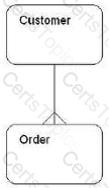Which of the following would BEST be managed with the "keep satisfied" stakeholder management strategy?
Which of the following is an example of 'Individual Tacit Knowledge'?
In which of the following circumstances is supplier power high?
"The system should allow a user to enter customer details and select appropriate customers for a mailshot". What is wrong with this requirement?
When analysing stakeholders, it is useful to produce a stakeholder analysis grid. What is depicted on the axes of this grid?
Which of the following is explicitly considered as a force in Porter's five forces model?
What is stage 0 (zero) of the concerns-based adoption model?
Business Analysis competencies are divided into three groups. Which of the following are the groups of competencies for a Business Analyst?
a. IT skills.
b. Behavioural skills and personal qualities.
c. Techniques.
d. Project Management Support.
e. Business Knowledge.
Which of the following describes the objectives in a MOST analysis?
Description, impact assessment, probability and countermeasures are usually recorded for which of the following?
What stage immediately precedes testing in the waterfall lifecycle?
What stage of the V model provides the test criteria for user acceptance testing?
Style guides, manuals and job descriptions are examples of what type of knowledge?
The entity relationship model below shows the relationship between Customer and Order. Which of the following business rules is correct?

A well-formed requirement is said to comply with which of the following acronyms?
A process model has been produced which includes diamond-shaped symbols. What does this diamond-shaped symbol represent in the model?
What do the arrow headed lines between activities represent on a business activity model?
Which of the following BEST describes an ethnographic study?
Which of the following statements about business activity models (BAM) is correct?
Which of the following statement is TRUE about the process view of an organization?
When are workshops especially valuable?
One of Porter's five forces explicitly considers industry competitors. Which of the following is the Key Focus' of this force?
Which of the following is an advantage to the host organization of using an internal consultant to conduct a business analysis project?
Which of the following is a perceived advantage of using workshops to investigate requirements?